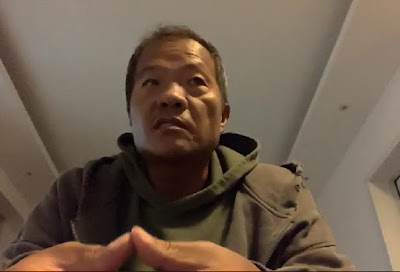by Patricia Frischer
 |
| Wang Qingsong found a 100 year-old bath house that they were about to demolish, so he rented
it for one day to take this photo before it was destroyed. |
How amazing is it that we can see a live talk with one of the world’s most famous artist and even get to ask questions? With a translator, this was such a special experience on zoom thanks to the San Diego Museum of Art. The exhibition is on view until August 14 at the first floor galleries 14 and 15.
Wang
Qingsong was born in 1966 into poor family from north east China. His father
died when he was a teen, and his mother was uneducated and so he needed to
assume responsibility for his family. He studied hard. He took 8 years to
get into art school. Out of 2000 applicant only 20 got into art school, so this
was a true sign of talent.
By
1992, China has entered a period where market economy was all. In 1993,
Qingsong became a professional oil painter and moved to Beijing, his first big
city experience. He knew nothing of the stress and expense for food and
shelter.
His
own early works were very personal about his intimate life. He wanted a new way
to express himself. At that time, only those in the government were allowed to
have a camera and take pictures. It was rare to own a camera or go onto the
street to take a photograph to capture a moment. He tried to make a fake
certificate as a journalist, but that did not work out. And actually he did not
want to make documentary statement like a photo journalist, but to use the word
"document" as a noun to show the social and economic changes. He
makes a statement by arranging the subjects and props as a composition as was
done in painting. He creates images that are critical of the Chinese life
style and commercialism, and they pose the question, “What is important?”
using sarcasm and even humor.
By1996, traditional values had broken down. People were excited to make lots of
money and develop the city scape. His series about Social Mobility started 20
years ago with changes in people's mentality, but now also physical
environments have changes. Traditional cities have become cities of
skyscrapers. One square meter was $500 and now 20 times as expensive ie.
$10,000. It was more friendly and small and local, now people are
estranged.
World-wide
his work is often seen as either anti-capitalism or anti-socialism which are
opposite from each other! His personal overview of the world is one where he
poses his own questions. When asked what the Chinese thought of his work, he
states that most Chinese like his work a lot because he is seen to attack capitalism
and also because the works reflects history and how China like to surpass other
countries. Chinese admire progress.
His biggest worry is that humans have lost the capacity to be empathetic and he wants to challenge them. But it is the sarcasm in the work where he most successfully makes his point.
China
is all about being the second largest market economy, but the cities were full
of rubble as shown in this before and after Buddha duo above.
Qingsong
thinks not only about differences between east and west cultural difference,
but he seems fascinated with concepts of past, present, future. History is not
truth, but what is recorded by human beings. And his interpretations shine new
light on what we might think we know.
 |
| A section of this long work. |
 |
| Detail in mid creation |
We
are showing just a few details from some of these works that made from 45 meter
rolls of photographic paper. They follow the tradition of oriental scrolls.
 |
| When his first child was born, he started this series on education |














No comments:
Post a Comment